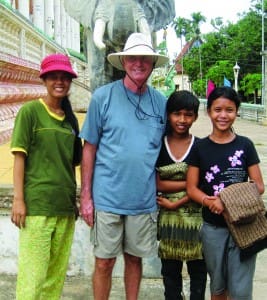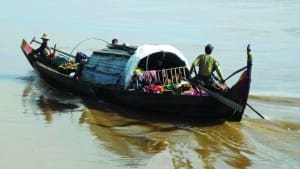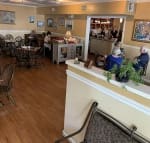KINGDOM OF CAMBODIA PART 2
Kingdom of Cambodia Part 2
Story By Judy Sullivan Photos by Bill Sullivan
There is a striking contrast between the bustling Vietnam and the more tranquil Cambodia. It remains a land immune to the flow of time. It too, has 2 distinct seasons: rainy with high humidity, and the dry season when the temperatures can reach as high as 104 degrees.

Cambodia, about the size of the state of Missouri, has changed its name a number of times. Most recently, during the reign of the Khmer Rouge, they insisted on the name Kampuchea. It is now known officially as the Kingdom of Cambodia, a constitutional monarchy with an elected king, chosen by the Royal Throne Council as head of state and a Prime Minister. All life centers on the family, and the family includes anyone in the bloodline reaching even remote cousins, no matter how far removed.
Sometimes, the travel experience is enriched by the foods we find. There are exceptions, however. The majority of the population is country folk and they find nothing strange in eating insects, algae or fish bladders. They will brew up brains or BBQ a frog, or anything that will sustain a body. This is not strange given their legacy of periods of famine. One signature dish we did sample and enjoy was Amoc. This is fish with coconut, lemon grass and chilies baked in a banana leaf. Rice porridge is a national tradition and can be found for breakfast, lunch and dinner.
No meal is complete without rice. Baguettes and donuts were introduced by the French and are still sold in baskets on the street sometimes even in artistic and imaginative shapes. We even found some shaped like crocodiles. It is never a challenge to find a beer. Like its counterpart, Tiger Beer in Viet Nam, Angkor Beer, the national beer of Cambodia, was tasty, plentiful and could be purchased on draught for under a dollar. The dollar is welcome here, too. In fact, this is the only country in the world we have visited where the ATM machines will, if prompted, deliver US dollars.


The typical greeting in Cambodia is the pressing of the hands together (as in prayer), and a slight bow. The higher the hands and the deeper the bow, the more respect is conveyed. We received this greeting at every encounter at the hotel, from the bus drivers and even some merchants in the street. Their social customs and taboos are similar to the Vietnamese, such as removing shoes and hats and covering the shoulders at religious sites, never showing the bottom of the feet, and never leaving the chopsticks in a bowl upright. Reminiscent of incense sticks at the temples, it is a symbol of death. They too, are a predominately Buddhist country and it is estimated there are over 60,000 monks there. Frequently, becoming a monk is the best, if not the only way, to receive an education. The duration of service ranges from a few years to a lifetime. We saw some on the streets dressed in the traditional saffron robes who appeared to be as young as 5.
Cambodia does have a pollution problem. Like their Vietnamese neighbors, the majority of the country suffers the ill effects of virtually non-existent sanitary facilities, even in urban areas. The river is used for the disposal of waste, garbage and sewage, a situation that is extremely hazardous to health. Traveling on the river, boats can be seen with an “outhouse” on the back. This is nothing more than a primitive wood structure for the purpose of modesty. The waste enters the river through a hole in the deck.
We began the cruise to Phnom Penh on the Tonle Sap River, a tributary of the Mekong, fed by the Tonle Sap Lake. During the wet season, the current in this river reverses its flow and fills the lake with its flood waters, protecting the Delta area from flooding.
Phnom Penh, the vibrant capital city, blends golden–roofed temples with French colonial buildings. It features wide boulevards and the Tonle Sap riverside walk where there is exercise equipment seemingly used constantly. It is the perfect introduction to the culture of the country, and we began with a cyclo tour of the city. These cyclos were more in the tradition of the rickshaw, hence more comfortable. We hurtled through the city, dodging bus and motorbike traffic. Seeing the sights from the street level gives one the opportunity to see everything, from the side streets with barbers cutting hair on the sidewalk, to Lexus dealerships and elegant embassies and government buildings. We circled the huge Independence Monument celebrating Cambodia’s independence from France in 1953 in a traffic island south of the Palace Quarter.
Our first visit was the magnificent Imperial Palace, inspired by the architecture of the ancient Khmer but built by the French in the 19th century. The area around the palace is known as the Palace Quarter with a large square used in the evenings as a gathering place for all ages. We enjoyed watching the children chasing the flocks of pigeons. I Guess children are children everywhere!
Located behind a protective wall the Palace is a huge complex divided into 3 compounds: the Silver pagoda, the Khemarin Palace and the central throne hall, still used for royal ceremonies. It is all surrounded by beautifully-maintained gardens and courtyards. The Silver pagoda is named for its floor paved with over 5000 silver tiles, each weighing a kilogram. It supposedly survived the Khmer Rouge in order for them to demonstrate to the outside world its concern for the conservation of Cambodia’s cultural riches. Inside, is a huge standing Buddha adorned with diamonds and a seated emerald Buddha. There is an equestrian statue of King Norodom outside. The Throne Hall has a 193-foot spire with 4 sculpted faces similar to those at Bayon at Angkor. Strikingly, there is also a French Pavilion given by Napoleon III as a gift to King Norodom, which bears no resemblance to the architecture of the surrounding buildings.
The Khmer Rouge reached Phnom Penh in 1975, led by Pol Pot, calling himself Brother No.1. Few anticipated the hell that followed. Pol Pot immediately evacuated all the cities and sent the entire population on forced marches to rural work projects. Proclaiming this the year zero, they attempted to rebuild the country’s agriculture on the model of the 11th century. This began unfathomable nightmares of cruelty and suffering and ruthless destruction of cultural heritage. Anyone suspected of being from the educated middle class was systematically tortured and murdered. They discarded western medicine, and destroyed temples, libraries and schools. At least 2 million Cambodians out of a population of 8 million, I quarter of the total population, died from executions, overwork, starvation and disease giving rise to the term Killing Fields.
The afternoon tour of the Tuol Sleng Genocide Museum was chilling. It is estimated that over 14,000 people were detained, tortured and killed here. It is surrounded by 2 rows of corrugated iron fence covered with dense barbed wire. It is located in the former primary and high school taken over by Pol Pot’s security forces and turned into a prison designed for detention, interrogation and inhumane torture. As soon as “confessions” from detainees were received, they were killed. There are photographs of the prisoners, some as young as 5, with paintings and eyewitness accounts of the murderous insanity here. The upper-floor corridors are wrapped in a fishnet of barbed wire in order to keep the prisoners from committing suicide by throwing themselves over the rail. 14 bodies were recovered following the liberation. These were the last of the prisoners to be tortured and killed by S-21 forces before they fled. They were unidentifiable, due to decomposition but are buried in the courtyard.
No less a grim experience, was the visit to Choeung Ek, the Killing Fields. This site is about 9 miles south of the prison and the location where the majority of the prisoners held at S-21 were executed and buried in mass graves. It is a stark reminder of the hideous cruelty of those times. Most were bludgeoned to death, or stripped naked and thrown into the crocodile pits to save precious bullets. The mass graves are said to contain remains of over 17,000 people. It is now a peaceful place with a glass-paneled memorial stupa, filled with approximately 8,000 skulls. In front of it are the craters of the excavated graves and a small museum. There are 43 of the known 129 graves unexcavated, but heavy rains will frequently bring teeth, bones and cloth fragments to the surface.
Three years, 8 months and 21 days after his entrance into Phnom Penh, the regime’s belligerence toward Viet Nam prompted an invasion by them, causing the Khmer Rouge to flee. Pol Pot escaped into the jungle, where he lived until 1998. His death was reported numerous times, and the population refused to believe his death, until his body was seen in the newspaper or on TV.
On a lighter note, the National Museum is home to some of the most beautiful of Khmer sculpture and artifacts along with bronzes and pottery from the 4th to the 8th century. It is built of terra cotta with four courtyards facing a central garden located near the Royal Palace. They claim that bats living in the roof come out at sunset, although we saw none. With an afternoon at leisure, we joined a group of fellow travelers at a local Irish pub, appropriately named Paddy Rice (He was a famous Irish boxer). Being from Scotland, they were interested in the current World Cup Rugby match being shown on TV there.
Cruising the river the next morning brought us views of village life. Floating markets, fishing boats, tombs and temples overlooking the river passed by until we reached the Khmer river community of Chong Koh. The island village is famous for its weaving, and the boat was met by children all anxious to wave hellos and practice their English. There were children getting their morning baths in the river and the cows tethered to the surrounding trees. Stepping off the boat brought hundreds of barefoot brown children all ready to sell you the weaving of their mothers and sisters. We had a walk through the village, but those who had “attached” themselves to us never left our sides! At the end of the tour, we purchased hand-woven scarves and tablecloths of Cambodian cotton (no silk is woven here) at very reasonable prices, and chatted with the children who had the most remarkable grasp of English! Our special friends were Vera, Lida and Lei, all who assured us they themselves had woven the scarves we purchased!
Kampong Cham is the heart of the Cambodian rubber industry. Rubber plantations stretch all across the province. Many are no longer commercially used, but are tapped by locals for their uses. We stopped at a large one, Chup Rubber Plantation, where we saw the trees and their cups. Kampong Cham is also known as the “waiting port,” a gateway to eastern and northern provinces. A hub for both the road and the river, enhanced by the opening of the bridge, it is the first and largest to span the Mekong in Cambodia.
We visited the hilltop temple of Wat Hanchey. This visit required a long, steep climb to the top of the hill, where again met by the children who all wanted to “hold our hand.” At the top of the hill, we were afforded a stunning view of the river below. The temple itself was built in the 8th century, but there is a large modern wat (places of worship, like churches) and is surrounded by small religious sites scattered along the hillside. There was a carnival atmosphere here, as it was still the celebration of P’chum Ben, a sort of All Souls day. During this 15-day festival, respects are paid to the dead through offerings at the wats. Gifts of food are brought to the tombs to honor the dead, as well as gifts of rice and paper money to the monks. We witnessed the parade of the monks who followed masked and costumed priests and received offerings of rice from those along the route.
The Twin Holy Mountains of Phnom Pros and Phnom Srei are still used in many traditional Khmer festivals. They are often referred to as Man Hill and Woman Hill. Legend has it that 2 teams, one male and the other female, worked in a competition at night to construct a stupa (burial tomb) on the hilltop before daybreak. The women built a fire; the men mistook it for daylight and ceased their work. Since the women won, it became tradition that the woman no longer had to ask for the man’s hand in marriage, the previous tradition. There are gardens with sculptures showing the life of Buddha, a huge reclining golden Buddha and a beautiful “library” (this term is often used for those buildings for which no known actual use can be determined). The gardens are also frequented by roving bands of monkeys.
On our return to the ship, we stopped at Amica Village. Lifted right out of a picture book, we found water buffalo returning home, workers gathering and planting rice, small children playing in the dirt and homes built on stilts with hammocks and animals beneath. Our guide enlisted the services of a small and very curious young boy to show us the way that the traditional scarves are used as a modesty drape for both men and women while relieving themselves without the benefit of indoor and private plumbing. For his services he received a small token of money which he proudly ran to show to his mother! The Pandaw line has adopted this village and the children are beautifully behaved; shy and staring with their big brown eyes. We had stopped outside of town at a small store to purchase candy and treats for the children and they were eagerly awaiting their chance to sing their song for the visitors (and get their rewards). They wanted to hear our song as well so we lapsed into a chorus of “If You’re happy and you know it, clap your hands”!
This marked the end of the cruise portion of the trip so after breakfast, we boarded a bus for the 3 hour trip through the Cambodian countryside to Siem Reap and the Angkor portion of the trip.
(Next month see Part 3 on Cambodia and return to Vietnam)







